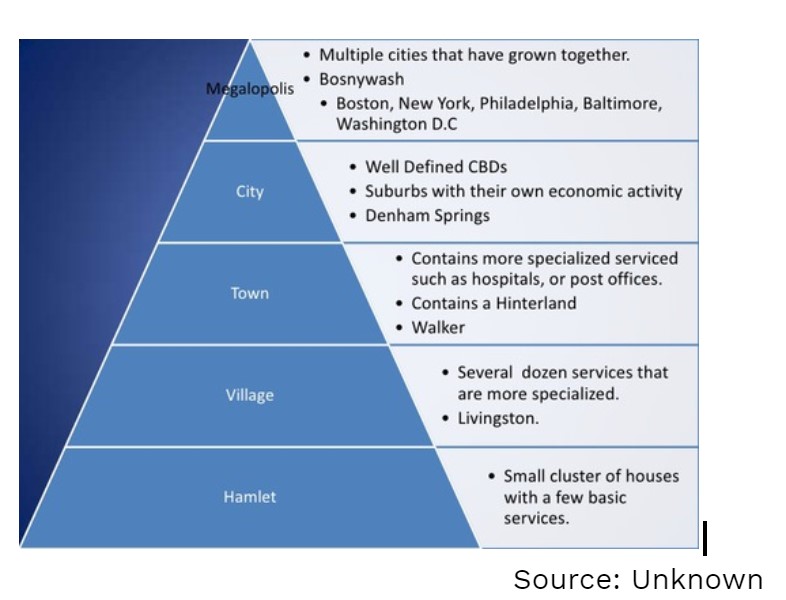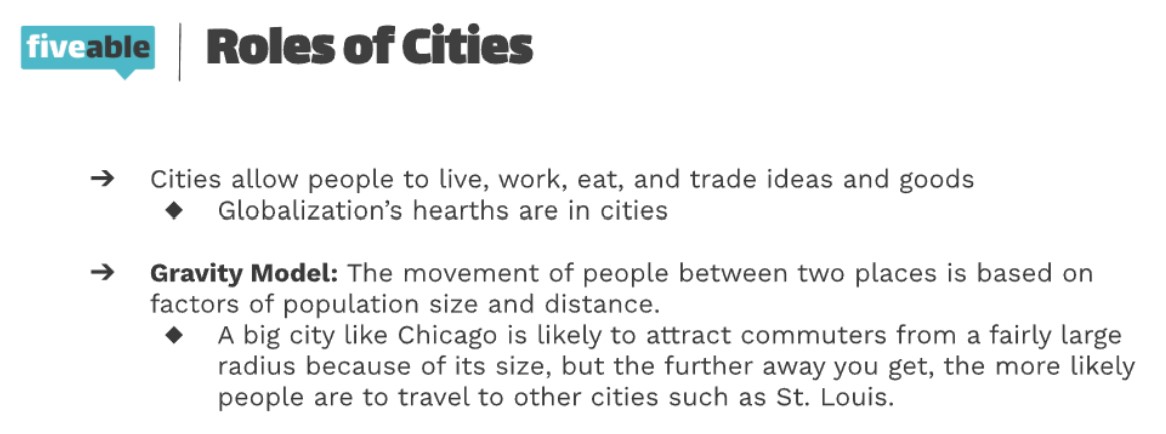Harrison Burnside
Riya Patel
AP Human Geography 🚜
320 resourcesSee Units
Cities
Louis Wirth, an American sociologist, defined a city as a "permanent settlement of relatively large size, relatively high population density, and relatively diverse population with respect to social and economic status, race, and culture." Wirth's definition of a city is based on three characteristics that distinguish cities from rural areas: large size, high population density, and social stratification and heterogeneity.
According to Wirth, the large size and high population density of cities create a sense of anonymity and impersonality among residents, and the social stratification and heterogeneity of cities create a sense of diversity and complexity. These characteristics of cities, Wirth argued, have important social and psychological consequences for the people who live in them.
Some examples of cities that may fit the characteristics of Wirth's city could include:
- New York City
- London
- Tokyo
- Hong Kong
- Singapore
Wirth's definition of a city has been influential in the field of sociology and has shaped the way that scholars and policymakers have thought about the nature and function of cities. It has also been subject to criticism and revision by subsequent scholars, who have pointed out that it is based on a narrow and Western conception of cities and that it does not adequately capture the complexity and diversity of urban life in other parts of the world.
Importance Of Cities in Different Sizes
Cities of different sizes can play important roles in regional, national, and global economies and societies.
Mega cities, or cities with a population of over 10 million people, are often major economic, political, and cultural centers, and are centers of innovation and creativity. They can be engines of economic growth and development, and can provide a wide range of amenities and services for their residents. However, mega cities can also face challenges such as pollution, inequality, and the negative impacts of globalization.
Large cities, or cities with a population of over 1 million people, can also be major economic, political, and cultural centers, and can provide a wide range of amenities and services for their residents. They can also be hubs of innovation and creativity, and can play a key role in regional and national economies.
Small cities, or cities with a population of less than 1 million people, can also play important roles in regional and national economies and can provide a high quality of life for their residents. They can be centers of innovation and creativity, and can provide a range of amenities and services, such as healthcare, education, and cultural activities.
Regardless of their size, cities can be important centers of economic, social, and cultural activity, and can provide a range of benefits to their residents and to the wider region or country in which they are located.

The urban hierarchy of cities refers to the classification of cities based on their size and importance. At the bottom of the hierarchy are the smallest settlements, such as hamlets and villages, which are often rural and have a small population. Above these are towns, which are typically larger than hamlets and villages and may have more developed infrastructure and a larger population. Cities are even larger and more developed, with a population of at least 100,000 and a more diverse range of industries and occupations.
A metropolis is a large city or urban area that is the economic, cultural, and political center of a region. A megalopolis is an even larger urban area, typically consisting of multiple cities and their surrounding suburbs that have grown together to form a continuous urban region. New York City is an example of a megalopolis, as it is made up of five boroughs and has a population of over 18 million people in its metropolitan area.
Type of City | Characteristics | Examples |
World City | A world city, also known as a global city or a meta city, is an urban center that is a major player in the global economy and is connected to a network of other global cities through economic, cultural, and political linkages. World cities are often centers of innovation and creativity, and they often have a significant influence on global trends and issues. World cities are characterized by high levels of economic activity, cultural influence, and connectivity to other global cities. They are often home to many international institutions, such as banks, embassies, and universities, and are centers of industries such as finance, media, and creative arts. World cities are also often major transportation hubs, with a comprehensive network of roads, railways, and airports. | Examples of world cities include New York City, London, and Tokyo, as well as other cities such as Paris, Hong Kong, and Singapore. These cities are often ranked and classified on scales such as the Alpha, Beta, and Gamma scale, based on their economic, cultural, and political importance to the global economy. |
Megalopolis | A megalopolis is a large urban region that is composed of multiple cities and their surrounding suburbs. Megalopolises are characterized by their size, complexity, and diversity, and are often centers of economic, political, and cultural activity. Megalopolises often have a population of over 10 million people, and they can cover large geographic areas, sometimes spanning multiple states or countries. They are typically composed of multiple urban centers that are connected by transportation networks and economic linkages, and they often have a strong influence on regional and national economies. Megalopolises can face challenges such as congestion, pollution, and inequality, and they can require careful planning and coordination to ensure their sustainability and livability. | Examples of megalopolises include the Northeast Megalopolis in the United States, which stretches from Boston to Washington, D.C., and the Pearl River Delta Megalopolis in China, which includes the cities of Hong Kong, Shenzhen, and Guangzhou.
|
Alpha City | The Alpha classification is used to rank cities based on their economic, cultural, and political importance to the global economy. Alpha cities are considered to be the most important global cities, and are often centers of innovation and creativity. They are often home to many international institutions, such as banks, embassies, and universities, and are centers of industries such as finance, media, and creative arts. Alpha cities are also often major transportation hubs, with a comprehensive network of roads, railways, and airports. | Examples of Alpha cities include New York City, London, and Tokyo, as well as other cities such as Paris, Hong Kong, and Singapore. The Alpha classification is often used in conjunction with other scales, such as the Beta and Gamma scales, to rank cities of increasing lower importance in the global economy. These scales are used to help understand the relative importance of cities in the global economy and to inform policy and investment decisions. |
Beta City | The Beta classification is used to rank cities based on their economic, cultural, and political importance to the global economy. Beta cities are considered to be important global cities, but are ranked below Alpha cities in terms of their overall importance. Beta cities are often centers of economic, cultural, and political activity, and can have a strong influence on regional and national economies. | Examples of Beta cities include Amsterdam, Barcelona, and Chicago, as well as other cities such as Sydney, Munich, and Toronto. Beta cities are often characterized by their high levels of economic activity, cultural influence, and connectivity to other global cities, but may not have the same level of global importance as Alpha cities. |
Gamma City | The Gamma classification is used to rank cities that are less important to the global economy than Alpha or Beta cities. Gamma cities may be important regional centers, but they do not have the same level of economic, cultural, or political influence as Alpha or Beta cities. They may be centers of industry and commerce, but they are not as significant as the higher ranked cities. | It is difficult to provide a list of specific cities that could be considered Gamma cities, as the classification is subjective and may vary depending on the criteria used to define it. However, some cities that may be considered Gamma cities could include:
|
New York City, London, and Tokyo are often considered to be the three main world cities, based on their economic, cultural, and political importance on a global scale. These cities are often referred to as "global cities" or "world cities," and are characterized by their high levels of economic activity, cultural influence, and connectivity to other global cities.
Other cities are often rated and ranked based on their economic, cultural, and political importance to the areas they serve, and are classified on a scale such as the Alpha, Beta, and Gamma scale. The Alpha scale is used to rank the most important global cities, while the Beta and Gamma scales are used to rank cities of increasing lower importance.
The Alpha scale includes cities such as New York City, London, and Tokyo, as well as other cities such as Paris, Hong Kong, and Singapore. The Beta scale includes cities such as Amsterdam, Barcelona, and Chicago, while the Gamma scale includes cities such as Adelaide, Bangalore, and Boston.
These scales are based on a variety of factors, such as the size and complexity of the city's economy, the level of cultural and political influence, and the extent of connectivity to other global cities. They are used to help understand the relative importance of cities in the global economy and to inform policy and investment decisions.

This graphic explains the role of cities and how different cities can attract different people from varying distances.
Browse Study Guides By Unit
🗺Unit 1 – Thinking Geographically
👪Unit 2 – Population & Migration
🕌Unit 3 – Cultural Geography
🗳Unit 4 – Political Geography
👨🌾Unit 5 – Agriculture & Rural Land-Use
🌇Unit 6 – Cities & Urban Land-Use
💸Unit 7 – Industrial & Economic Development
🧐Exam Skills
📚Study Tools

Fiveable
Resources
© 2025 Fiveable Inc. All rights reserved.